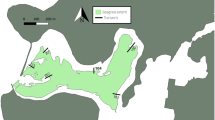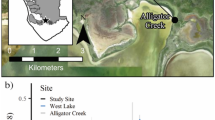Abstract
Surface water flow controls water velocities, water depths, and residence times, and influences sediment and nutrient transport and other ecological processes in shallow aquatic systems. Flow through wetlands is substantially influenced by drag on vegetation stems but is also affected by microtopography. Our goal was to use microtopography data directly in a widely used wetland model while retaining the advantages of the model’s one-dimensional structure. The base simulation with no explicit treatment of microtopography only performed well for a period of high water when vegetation dominated flow resistance. Extended simulations using microtopography can improve the fit to low-water conditions substantially. The best fit simulation had a flow conductance parameter that decreased in value by 70 % during dry season such that mcrotopographic features blocked 40 % of the cross sectional width for flow. Modeled surface water became ponded and flow ceased when 85 % of the cross sectional width became blocked by microtopographic features. We conclude that vegetation drag dominates wetland flow resistance at higher water levels and microtopography dominates at low water levels with the threshold delineated by the top of microtopographic features. Our results support the practicality of predicting flow on floodplains using relatively easily measured physical and biological variables.







Similar content being viewed by others
References
Anderson MP, Woessner WW (1992) Applied groundwater modeling: simulation of flow and advective transport. Academic, San Diego
Bolster CH, Saiers JE (2002) Development and evaluation of a mathematical model for surface water flow within the Shark River Slough of the Florida Everglades. Journal of Hydrology 259:221–235
Choi J, Harvey JW (2000) Quantifying time-varying ground-water discharge and recharge in wetlands of the northern Florida Everglades. Wetlands 20(3):500–511
Chow VT (1959) Open-channel hydraulics. McGraw-Hill Book Co., Inc., New York
Doherty J (2001) PEST-ASP user’s manual. Watermark Numerical Computing, Brisbane
German ER (2000) Regional evaluation of evapotranspiration in the Everglades, Water-Resources Investigations Report 00-4217, 55 pp. U.S. Geological Survey, Tallahassee
Hammer DE, Kadlec RH (1986) A model for wetland surface water dynamics. Water Resources Research 22(13):1951–1958
Harvey JW, Krupa SL, Gefvert C, Mooney RH, Choi J, King SA, Giddings JB (2002) Interactions between surface water and ground water and effects on mercury transport in the north-central Everglades, Water-Resources Investigations Report 02-4050, 82 pp. U.S. Geological Survey, Reston
Harvey JW, Newlin JT, Choi J (2003) Characterization of microtopography in the Everglades, in U.S. Geological Survey Greater Everglades Science Program–2002 Biennial Report, Open-File Report 03-54, compiled by A.E. Torres et al., pp. 37–38, U.S. Geological Survey, Tallahassee, Florida
Harvey JW, Krupa SL, Krest JM (2004) Ground-water recharge and discharge in the central Everglades. Ground Water 42(7):1090–1102
Harvey JW, Newlin JT, Krupa SL (2006) Modeling decadal timescale interactions between surface water and ground water in the central Everglades, Florida, USA. Journal of Hydrology 320:400–420
Harvey JW, Schaffranek RW, Noe GB, Larsen LG, Nowacki DJ, O’Connor BL (2009) Hydroecological factors governing surface water flow on a low-gradient floodplain. Water Resources Research 45, W03421. doi:10.1029/2008WR007129
Harvey JW, Drummond JD, Martin RL, McPhillips LE, Packman AI, Jerolmack DJ, Stonedahl SH, Aubeneau AF, Sawyer AH, Larsen LG, Tobias CR (2012) Hydrogeomorphology of the hyporheic zone: stream solute and fine particle interactions with a dynamic streambed. J Geophys Res 117. doi:10.1029/2012JG002043
He G, Engel V, Leonard L, Croft A, Childers D, Laas M, Deng Y, Solo-Gabriele HM (2010) Factors controlling surface water flow in a low-gradient subtropical wetland. Wetlands. doi:10.1007/s13157-010-0022-1
Jensen JR, Rutchey K, Koch MB, Narumalani S (1995) Inland wetland change detection in the Everglades Water Conservation Area 2A using a time series of normalized remotely sensed data. Photogrammetric Engineering and Remote Sensing 61(2):199–209
Kadlec RH (1990) Overland flow in wetlands–vegetation resistance. Journal of Hydraulic Engineering 116(5):691–706
Kadlec RH, Knight RL (1996) Treatment wetlands, 893 pp. Lewis Publishers, Boca Raton
Kadlec RH, Hammer DE, Nam IS, Wilkes JO (1981) The hydrology of overland flow in wetlands. Chemical Engineering Communications 9:331–344
Kaplan D, Paudel R, Cohen M, Jawitz J (2012) Orientation matters: patch anisotropy controls discharge competence and hydroperiod in a patterned peatland. Geophysical Research Letters 39, L17401. doi:10.1029/2012GL052754
Kjellin J, Worman A, Johansson H, Lindahl A (2007) Controlling factors for water residence time and flow patterns in Ekeby treatment wetland, Sweden. Sciencedirect 30:838–850
Larsen LG, Harvey JW (2011) Modeling of hydroecological feedbacks predicts distinct classes of landscape pattern, process, and restoration potential in shallow aquatic ecosystems. Geomorphology. doi:10.1016/j.geomorph.2010.03.015
Larsen LG, Choi J, Nungesser MK, Harvey JW (2012) Directional connectivity in hydrology and ecology. Ecological Applications 22(8):2204–2220
Lee JK, Roig LC, Jenter HL, Visser HM (2004) Drag coefficients for modeling flow through emergent vegetation in the Florida Everglades. Ecological Engineering 22:237–248
Lightbody AF, Nepf HM (2006) Prediction of velocity profiles and longitudinal dispersion in emergent salt marsh vegetation. Limnology and Oceanography 51(1):218–228
McCormick PV, Shuford RBE III, Backus JG, Kennedy WC (1998) Spatial and seasonal patterns of periphyton biomass and productivity in the northern Everglades, Florida, U.S.A. Hydrobiologia 362:185–208
McKillop R, Kouwen N, Soulis ED (1999) Modeling the rainfall-runoff response of a headwater wetland. Water Resources Research 35(4):1165–1177
McVoy CW (2000) Patterns, niches and mechanisms in the ridge and slough landscape implications for restoration, presented at Greater Everglades Ecosystem Restoration Science Conference, South Florida Ecosystem Restoration Task Force and Working Group Naples, Florida, December 11–15, 2000
Min JH, Paudel R, Jawitz JW (2010) Spatially distributed modeling of surface water flow dynamics in the Everglades ridge and slough landscape. Journal of Hydrology. doi:10.1016/j.jhydrol.2010.06.023
Nadeau TL, Rains MC (2007) Hydrological connectivity between headwater streams and downstream waters: how science cab inform policy. Journal of the American Resources Association 43(1):118–133
National Research Council (2002) Riparian areas–functions and strategies for management, 428pp. NRC Press, Washington
Nepf HM (1999) Drag, turbulence and diffusivity in flow through emergent vegetation. Water Resources Research 35:479–489
Nepf HM, Ghisalberti M, White B, Murphy E (2007) Retention time and dispersion associated with submerged aquatic canopies. Water Resources Research 43, W04422. doi:10.1029/2006WR005362
Newman AE, Keim RF (2013) Mesoscale connectivity through a natural levee. Hydrology and Earth System Sciences 17:691–704
Nuttle WK (1989) Comment on “A model for wetland surface water dynamics” by D.E. Hammer and R.H. Kadlec. Water Resources Research 25(5):1060–1062
Paudel R, Grace KA, Galloway S, Zamorano M, Jawitz JW (2013) Effects of hydraulic resistance by vegetation on stage dynamics of a stormwater treatment wetland. Journal of Hydrology 484(25):74–85
Petryk S, Bosmajian G (1975) Analysis of flow through vegetation. Journal of Hydraulics Division, Proceedings of ASCE 101(HY7):871–884
Poeter EP, Hill MC (1998) Documentation of UCODE—a computer code for universal inverse modeling, Water-Resources Investigations Report 98-4080, 116 p. U.S. Geological Survey, Denver
Restrepo JI, Montoya AM, Obeysekera J (1998) A wetland simulation module for the MODFLOW ground water model. Ground Water 36(5):764–770
Riscassi AL, Schaffranek RW (2003) Flow velocity, water temperature, and conductivity in Shark River Slough, Everglades National Park, Florida: August 2001–June 2002, Open-File Report 03-348, 37 p. U.S. Geological Survey, Reston
Romanowicz E, Richardson CJ (2000) Modeling hydroperiods and flooding depths in the northern Everglades, Water Conservation Area 2A, presented at Intecol–MilleniumWetland Event and Annual Meeting, Society of Wetland Scientists, Quebec City, Canada, August 6–12
Rutchey K, Vilchek L (1999) Air photointerpretation and satellite imagery analysis techniques for mapping cattail coverage in a northern Everglades impoundment. Photogrammetric Engineering and Remote Sensing 65(2):185–191
Rybicki NB, Reel JT, Gammon PT, Garrett MK (2002) Vegetative resistance to flow in south Florida Everglades–summary of vegetation sampling in Water Conservation Area 2A, September 1999, Open-File Report 02-38, 42 pp. U.S. Geological Survey, Reston
Scarlatos PD, Tisdale TS (1989) Simulation of wetland flow dynamics, water: laws and management. American Water Resources Association, Bethesda, pp 9A-15–9A-23
Science Coordination Team (2003) The role of flow in the everglades ridge and slough landscape, report, South Florida Ecosystem Restoration Working Group
Shih SF, Rahi GS (1982) Seasonal variations of Manning’s roughness coefficient in a subtropical marsh. Transactions of the American Society of Agricultural Engineers 25(1):116–120
South Florida Water Management District (2005a) RSM user manual–HSE v1.0. SFWMD, West Palm Beach, 286 p
South Florida Water Management District (2005b) Documentation of the South Florida Water Management Model v5.5. SFWMD, West Palm Beach, 305 p
Stern DA, Khanbilvardi R, Alair JC, Richardson W (2001) Description of flow through a natural wetland using dye tracer tests. Ecological Engineering 18:173–184
Thompson GT, Roberson JA (1976) A theory of flow resistance for vegetated channels. Transactions of the American Society of Agricultural Engineers 19(2):288–293
Turner AK, Chanmeesri N (1984) Shallow flow of water through non-submerged vegetation. Agricultural Water Management 8:375–385
Watts DL, Cohen MJ, Heffernan JB, Osborne TZ (2010) Hydrologic modification and the loss of self-organized patterning in the Ridge–Slough Mosaic of the Everglades. Ecosystems 13:813–827
Wilsnack MM, Welter DE, Montoya AM, Restrepo JI, Obeysekera J (2001) Simulating flow in regional wetlands with the MODFLOW wetlands package. Journal of the American Water Resources Association 37(3):655–674
Wu Y, Wang N, Rutchey K (2006) An analysis of spatial complexity of ridge and slough patterns in the Everglades ecosystem. Ecological Complexity 3:183–192
Acknowledgments
This work was funded by the U.S. Geological Survey Greater Everglades Priority Ecosystem Science Program, the U.S. Geological Survey National Research Program, the South Florida Water Management District, the National Park Service through agreement IAA F5284-08-0024, and the Army Corps of Engineers. We thank Laurel Larsen, Chris McVoy, and Fred Sklar for sharing their expertise and advice about characterizing flow and microtopography in the Everglades.
Author information
Authors and Affiliations
Corresponding author
Rights and permissions
About this article
Cite this article
Choi, J., Harvey, J.W. Relative Significance of Microtopography and Vegetation as Controls on Surface Water Flow on a Low-Gradient Floodplain. Wetlands 34, 101–115 (2014). https://doi.org/10.1007/s13157-013-0489-7
Received:
Accepted:
Published:
Issue Date:
DOI: https://doi.org/10.1007/s13157-013-0489-7




